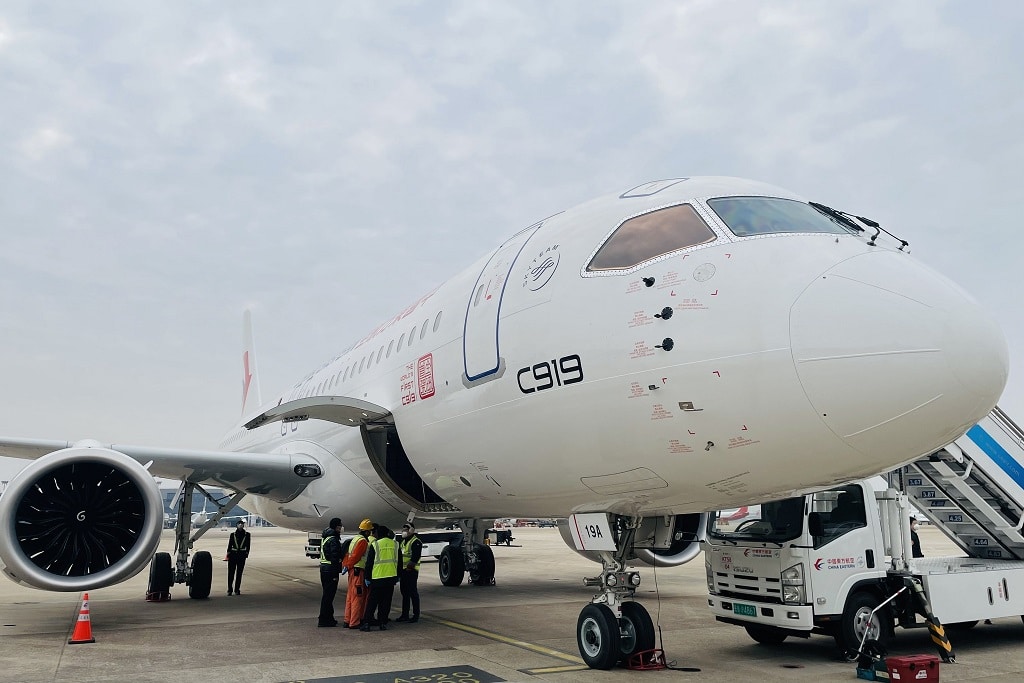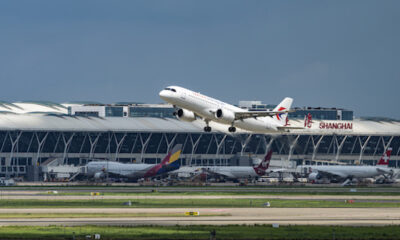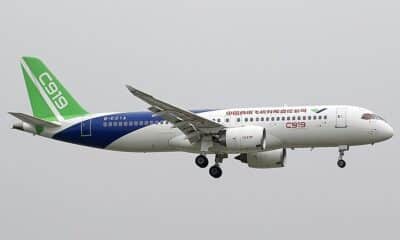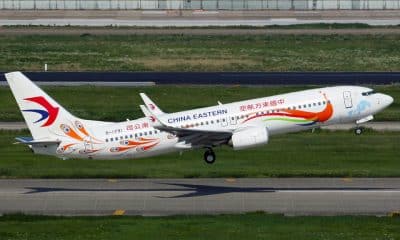Airlines
The C919 from China Eastern Airlines has begun its final verification flight.

China Eastern Airlines, the world’s first launch client, received the first C919 aircraft, with registration number B-919A, on December 9.
China Eastern Airlines received the first domestic narrow-body aircraft that COMAC had delivered, and now that aircraft has begun its validation flight, which will involve nearly 100 hours of flight time, numerous passenger operations checks, and mock-up exercises for aircraft maintenance and operation. from Monday to the middle of February 2023, including 9 Chinese provinces. The aircraft appears to be competent for passenger operations.
The C919 is China’s first homegrown large passenger aircraft in accordance with international airworthiness standards and owns independent intellectual property rights. It features an advanced aerodynamic design, propulsion system, and materials, as well as lower carbon emissions and higher fuel efficiency.
The aircraft adopts a 164-seat configuration that comes with a two-class cabin layout, including 8 business class seats and 156 economy class ones. In the economy cabin, the middle seat in each three-seat row is 1.5 cm wider than its neighboring ones, which offers more comfort.
With an aisle height of 2.25 meters, the plane comes with an efficient air filtration system, a passenger-centric lighting system and low noise. Besides, there are twenty 12” drop-down screens that can play 1080P videos.
On December 26, 2022, a 100-hour verification flight was started by the world’s first C919 that had just been delivered to #CEAir. At 13:25, Shanghai Hongqiao International Airport (IATA: SHA, ICAO: ZSSS) launched the first flight, MU7801, which touched down at Beijing Capital International Airport (IATA: PEK, ICAO: ZBAA) at 15:17. The aircraft will undergo a thorough test during the verification flight to ensure the safety of its operation, clearing the way for its commercial debut in the spring of 2023.

Aerospace
Which is bigger 777x or 787 aircraft ?

The 777X is a new series of the Boeing 777 family and is designed to be larger and more efficient than its predecessor. It features two variants: the 777-8 and the 777-9, being the larger of the two.
The Boeing 777X emerges as the larger sibling within the Boeing family, representing a significant leap forward in both size and efficiency. Comprising two variants, the 777-8 and the 777-9, the latter takes the crown as the larger of the two. With its expansive fuselage and impressive wingspan, the 777X is tailored for long-range journeys and boasts a substantial passenger capacity.
On the other hand, the Boeing 787, affectionately known as the Dreamliner, occupies a niche in the market as a smaller yet formidable aircraft designed for medium to long-range flights. Its distinguishing feature lies in its composite fuselage, a technological marvel that renders it lighter and more fuel-efficient compared to conventional aluminum counterparts. The Boeing 777X is larger than the Boeing 787 aircraft.
When it comes to passenger capacity, the 777-9 reigns supreme, typically accommodating a sizeable contingent of 400-425 passengers in its standard configuration. In contrast, the 787, with its more modest dimensions, typically carries between 240-290 passengers, depending on the variant and layout.
One of the remarkable innovations introduced with the 777X is its folding wingtips, a feature designed to address the logistical challenges of accommodating such a large aircraft in conventional airport gates. These folding wingtips enable the 777X to retract its wings, allowing it to fit into gates designed for smaller aircraft while still reaping the benefits of an extended wingspan during flight, thereby enhancing fuel efficiency and operational flexibility
Airlines
Why Don’t Airplanes Fly Over the Pacific Ocean?

Flights do indeed fly over the Pacific Ocean, but the routes they take are often determined by factors such as airline policies, air traffic control decisions, and weather conditions. The Pacific Ocean is one of the largest bodies of water on Earth, and it’s regularly crossed by numerous flights traveling between North America, Asia, Australia, and other destinations.
However, some specific routes might avoid flying directly over certain parts of the Pacific Ocean for various reasons. For example:
- Safety and emergency considerations: While modern aircraft are equipped with advanced safety features, airlines, and pilots may prefer routes that keep them closer to potential diversion airports or within range of search and rescue facilities in case of emergencies.
- Air traffic control restrictions: Airspace management authorities may impose certain restrictions or preferred routes for managing air traffic efficiently. These restrictions could be based on factors such as military operations, airspace congestion, or diplomatic considerations.
- Weather conditions: Pilots and airlines consider weather patterns when planning routes. While the Pacific Ocean generally experiences fewer weather-related disruptions compared to other regions, factors like turbulence, thunderstorms, or tropical cyclones can influence route selection.
- Managing Cost Factors: In route planning, airlines have to take fuel prices, maintenance costs, crew charges, and other operating costs into account. Direct routes over the Pacific Ocean may be more cost-effective for shorter distances, but they may also necessitate extra safety precautions, including carrying more fuel for longer overwater operations.
- Remote Locations and Navigational Challenges: The Pacific Ocean’s vastness poses navigational issues, particularly for aircraft operating over isolated regions with few ground-based navigational aids. For precise positioning and route direction, pilots must mostly rely on satellite-based technology and onboard navigation systems, which may necessitate additional training and equipment purchases.
- Lack of Suitable Landing Options in the Pacific Ocean: Unlike regions with dense air traffic and numerous airports, the Pacific Ocean has vast stretches of open water with few suitable landing options in case of emergencies. While long-range aircraft are equipped with safety features like life rafts and emergency locator transmitters, the lack of nearby airports can increase the time it takes for rescue and recovery operations to reach distressed aircraft, posing additional risks to passengers and crew. Therefore, flight routes may be planned to ensure proximity to potential diversion airports or alternate landing sites in case of unforeseen circumstances.
Airlines
Oldest Qantas A380 returns to service after being in storage : 16 years +
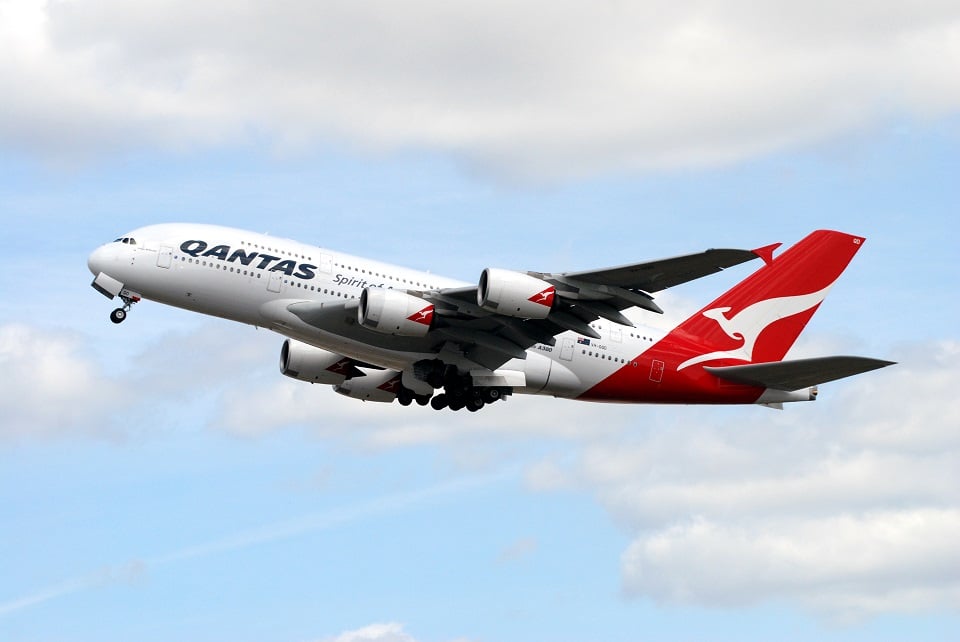
The Airbus A380 stands as an icon in the aviation world, captivating travelers with its engineering marvel. However, the COVID-19 pandemic led to a halt in its production, causing a surge in demand for airline travel and a scarcity of these aircraft. Now, many airlines are eager to reintroduce the A380 into their fleets to address this shortage.
Qantas, among the airlines, had one of its A380 aircraft sitting in storage for over 16 years. Now, they’re keen to put it back into service to meet the soaring demand. Meanwhile, Emirates, Etihad, and British Airways continue to operate their A380s.
Qantas’s A380, which made its debut landing at London Gatwick, had initially landed at 07:45 BST from Sydney via Singapore. Operated by the registration VH-OQJ, this flight marked a significant return to service.
Another Qantas A380, registered as VH-OQA, recently resumed operations after being stored in Abu Dhabi for over a year. Its return to Sydney on April 5 signaled its readiness to serve again. This fifteen-and-a-half-year-old aircraft made its first post-storage flight on April 6, a 13-hour journey from SYD to LAX, devoid of passengers. Shortly after arrival, it was swiftly deployed for a long-haul flight, QF11, from SYD to LAX.
These trial flights, including the Sydney to London Gatwick route, demonstrate the aircraft’s renewed capability for regular services.
Qantas, like other carriers, faces a challenge in meeting the surging passenger demand with its existing fleet. Hence, the decision to bring back stored aircraft to service is a strategic move to cater to this growing need.
Delivered to Qantas in September 2008, this A380 boasts 12 units, all equipped with Rolls-Royce Trent 900 engines and a maximum take-off weight of approximately 570,000 kg (~1.26 million lbs). Most have a seating capacity of 485, including 14 first-class seats.

